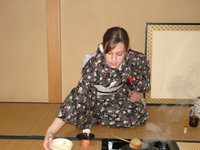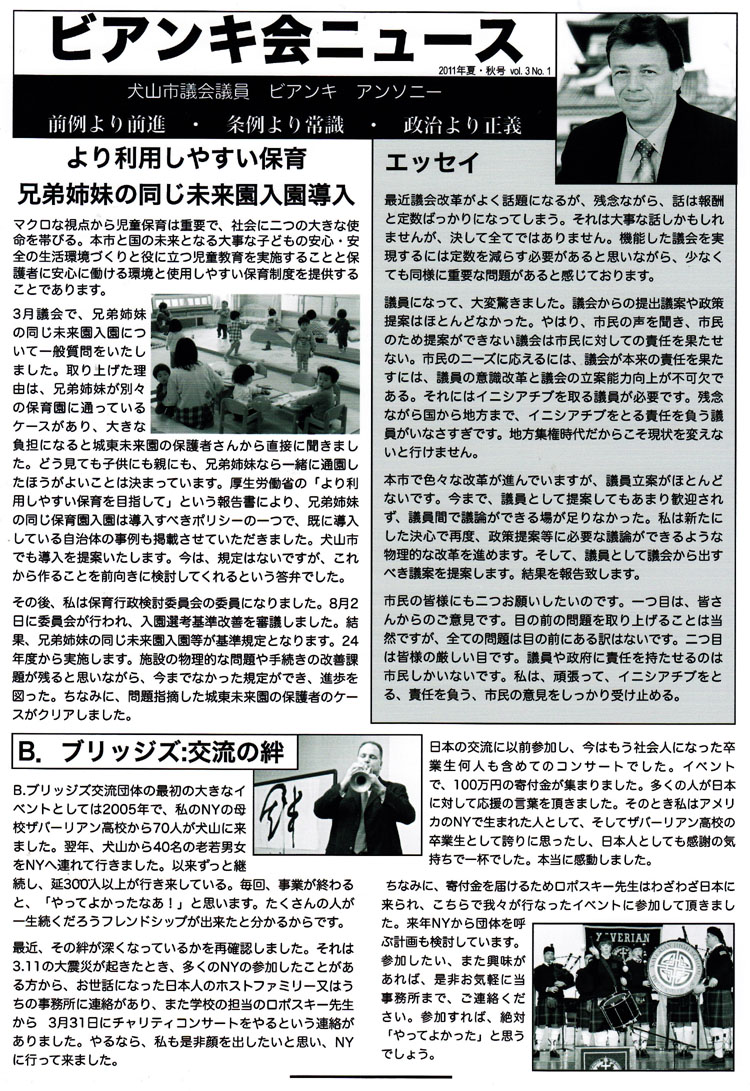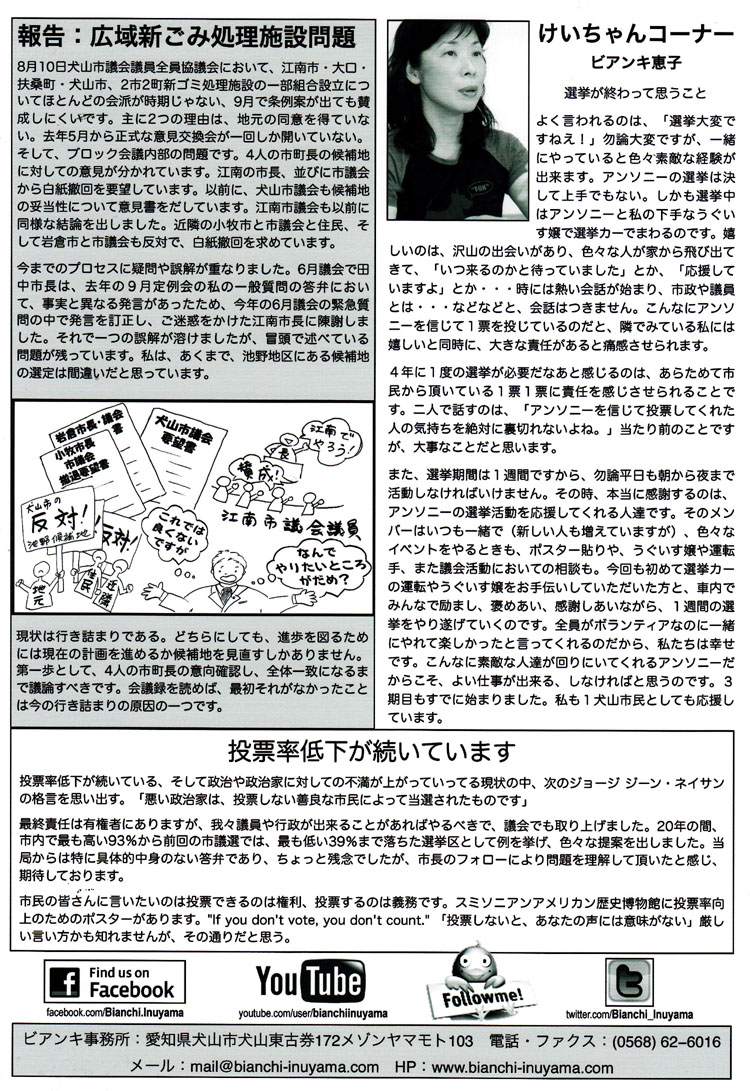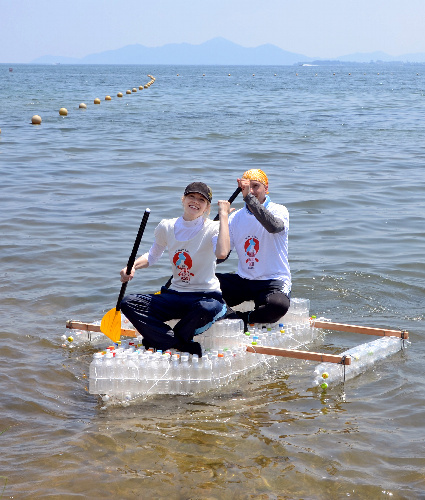Return to Tohoku: Tanya Gardecky “Hi ho! It’s off to school I go!”
******************
Tanya Gardecky (Miyagi-ken, Shiogama-shi) is one of the 20 Tohoku region JET alumni selected by the Ministry of Foreign Affairs (MOFA) to return to their town to both engage in volunteer efforts and also help document and share what’s going on there.
Here’s an excerpt from Tanya’s latest post: “Hi ho! It’s off to school I go!”
But when I went to the grade 3 classes the teachers changed it a bit and had some of the students mention their experience with the March 11th earthquake and tsunami. From what I understood, the students were very surprised by the earthquake and were confused about the tsunami. Some didn’t believe the tsunami was happening or that it was that big, others simply had no idea what was happening.
JETwit will continue to post updates from Tanya and other participating alums. You can also follow Tanya’s blog at http://www.travelblog.org/Bloggers/ShiogamaJET/.
Click here to read other “Return to Tohoku” posts.
If you are returning to Tohoku and would like to share your updates, please feel free to e-mail jetwit [at] jetwit.com.
AJET’s revamped website continues to impress. There’s now a section called AJET Voices that lists all the main JET online publications and also invites JETs to submit an article. The goal is to help JETs connect with their communities.
Here are the publications listed:
- The Wide Island View (Hiroshima)
- Yomoyama
- NagaZasshi (Nagasaki)
- Ganbatte Times: The Unofficial Kyoto JET Webzine
- The Refill (Fukuoka)
- The Hyogo Times
- HAJET (Hokkaido)
- The TRAM (Toyama)
- JETFuel
- Shimane Black Taxi
- Mie Life
- Ishikawa JET (Thanks to Leah Zoller for calling this one to our attention.)
For more about AJET Voices, here are AJET’s own words:
Have you done something you felt was special? Want to promote an event you are involved in? Just want to get published? AJET Voice is AJET’s way of connecting you with the rest of the JET community throughout Japan. All JETs are encouraged to submit and share their experiences with everyone.
The JET Programme is all about multicultural exchange and grassroots internationalization. If you have participated in something which you felt furthered these goals, please share it with the rest of us! Submit your articles of 200-300 words with any pictures to activities@ajet.net
Publications across Japan
Currently representing voices from Nagano, Hyogo, Toyama and many others, the site is growing in hopes of being a resources for all of Japan and those interested in the perspectives born from living here as a foreign resident.
By Prefecture
Many of the publications represented on the site are fundamentally newsletters, PDFs, or print magazines. If you are interested in or reside in the prefecture of a specific publication and wish to submit or regularly receive it, please don’t hesitate to contact us.
AJET
All of the publications on this site are in some way connected to the JET program and often each prefecture’s AJET (Association Japan Exchange and Teaching) branch. Submissions from guest writers and non-JET program teachers is extremely common and decided by each publication along with the content and editorial vision.
As a unified site, all content abides by the site’s editorial ethic not to publish any content felt to be uncritically prejudiced or offensive.
Return to Tohoku: JETAA Sydney’s Sharon Van Etten
******************
Sharon Van Etten (CIR Iwate-ken), President of JETAA Sydney, is another Tohoku region JET alumni selected by the Ministry of Foreign Affairs (MOFA) to return to their town to both engage in volunteer efforts and also help document and share what’s going on there.
You can follow Sharon’s blog Revisiting Iwate at: http://revisitingiwate.blogspot.com/
JETwit will continue to post updates from Sharon and other participating alums. Click here to see previous “Return to Tohoku” posts.
If you are returning to Tohoku and would like to share your updates, please feel free to e-mail jetwit [at] jetwit.com.
Return to Tohoku: JET alum Tanya Gardecky arrives in Shiogama
Tanya Gardecky (Miyagi-ken, Shiogama-shi) is one of the 20 Tohoku region JET alumni selected by the Ministry of Foreign Affairs (MOFA) to return to their town to both engage in volunteer efforts and also help document and share what’s going on there.
Here’s an excerpt from Tanya’s latest post:
I eventually made it Shiogama (and instantly noticed some damage around the train station) and went city hall. There I was greeted by the Mayor and vice-mayor, along with many staff from the Shiogama Board of Education, and they welcomed me back. We talked about the state of the city after the earthquake, and I was shown a book full of photos of the damage in Tohoku. Most I had seen in the news already but to see them all in one book was a bit of a shock. They said they had made much progress in the reconstruction, and this was something I wanted to see. From city hall I went to the Board of Education to meet the staff again and to discuss my week. It’s a very busy schedule but I know I can’t afford to get worn out because there are people, places, and things I want to and need to see.
JETwit will continue to post updates from Tanya and other participating alums. You can also follow Tanya’s blog at http://www.travelblog.org/Bloggers/ShiogamaJET/.
If you are returning to Tohoku and would like to share your updates, please feel free to e-mail jetwit [at] jetwit.com.
**************
Thanks to JETAA USA Country Rep Megan Miller (Hyogo-ken) for sharing the below article from Kyodo News:
Family of U.S. quake victim to donate money for books in Miyagi
http://callcenterinfo.tmcnet.com/news/2011/08/25/5730320.htm
TOKYO, Aug. 25 — (Kyodo) The family of an American teacher who was killed in the March 11 earthquake and tsunami will visit Japan in September to donate money for books to seven schools in Ishinomaki, Miyagi Prefecture, where she taught, the Japanese Foreign Ministry said Thursday.
The family of Taylor Anderson, 24, who taught English at the Ishinomaki schools under the Japan Exchange and Teaching Program, will donate a total of around 7 million yen to set up reading corners named after her in the libraries of the schools, according to supporters of the project.
Latest Newsletter from Councilman Anthony Bianchi
************
Here’s the newest newsletter from JET alum and Inuyama City Council Member Anthony Bianchi (Aichi-ken, Inuyama-shi, 1988-89):
***Page 1***
CLICK HERE for more JETwit posts about Anthony Bianchi.
Show off your translating skills! An English translation or summary of some or all of the above would be great if any readers are up for it. Full credit will be given!
Return to Tohoku: JET alum Tanya Gradecky arrives in Japan
Tanya Gardecky (Miyagi-ken, Shiogama-shi) is one of the 20 Tohoku region JET alumni selected by the Ministry of Foreign Affairs (MOFA) to return to their town to both engage in volunteer efforts and also help document and share what’s going on there.
Here’s a quick excerpt from the first post on her travel blog:
“I’m about to head off to the Ministry of Foreign Affairs for a meeting and then I will be on my way to Sendai and Shiogama City in Miyagi Prefecture!!”
JETwit will continue to post updates from Tanya and other participating alums. You can also follow Tanya’s blog at http://www.travelblog.org/Bloggers/ShiogamaJET/.
If you are returning to Tohoku and would like to share your updates, please feel free to e-mail jetwit [at] jetwit.com.
Another Canadian JET to visit Tohoku via the MOFA program
Turns out the Ottowa Citizen article was not entirely correct about Brent Stirling (Fukushima-ken, Fukushima-shi, 2006-10) being the only Canadian among the 20 ex-JETs selected for the MOFA program to go back to their town/city in Tohoku, help with volunteering and write about and share their experience.
But the post on JETwit about the article did help generate a response from Toronto-based JET alum Tanya Gardecky (Miyagi-ken, Shiogama-shi) who will also be participating and whose travel blog you can follow here: http://www.travelblog.org/Bloggers/ShiogamaJET/
********************
Here are a few JET-related articles and radio piece written and produced in the past month by JET Alum Bluegrass Subchapter member Graham Shelby (Fukushima-ken). (Thanks to Graham for sharing the info.)
- Graham went to Nashville at the end of July to interview some of the new JETs about to depart from the consulate there. Here’s a radio piece he produced that aired this past week on the public radio station here in Louisville. (It’s short.)
http://www.wfpl.org/2011/08/15/audio-new-teachers-prepare-for-life-in-japan/
- Graham also put together a quick piece focusing on one of new JETs who happens to be headed to Fukushima. It aired a few times on NPR’s national newscasts during Morning Edition on August 1. They don’t archive the newscasts online, the newscaster’s intro sounded something like this:
“While many people are struggling to find jobs, hundreds of Americans, many of them recent college graduates, have found an employer eager to hire them – in Japan. From member station WFPL, Graham Shelby has more.”
- Lastly, Graham did another short piece that was Kentucky-specific that was picked up by a few stations here.http://www.wfpl.org/2011/07/30/kentuckians-prepare-for-japanese-teaching-assignments/
As Graham’s work demonstrates, there are clearly opportunities to find and tell compelling stories from the world of JETs and former JETs. If you have any ideas, angles, upcoming events or possible outlets in mind, please feel free to contact Graham gshelby3 [at] gmail.com.
Tsunami: JET alum Harvard professor Ian Miller’s NY Times article
*************
Thanks to a recent conversation with Peter Kelley, President of the National Association of Japan-America Societies, I just learned of this New York Times article by Harvard history professor and JET alum Ian Miller (Miyagi-ken, Miyako-shi) which ran March 19, 2011.
Bitter Legacy, Injured Coast
http://www.nytimes.com/2011/03/20/opinion/20miller.html?_r=1&pagewanted=1
By IAN JARED MILLER
Cambridge, Mass.
THE rugged Sanriku Coast of northeastern Japan is among the most beautiful places in the country. The white stone islands outside the port town of Miyako are magnificent. The Buddhist monk Reikyo could think of nothing but paradise when he first saw them in the 17th century. “It is the shore of the pure land,” he is said to have uttered in wonder, citing the common name for nirvana.
Reikyo’s name for the place stuck. Jodogahama, or Pure Land Beach, is the main gateway to the Rikuchu Kaigan National Park, a crenellated seashore of spectacular rock pillars, sheer cliffs, deep inlets and narrow river valleys that covers 100 miles of rural coastline. It is a region much like Down East Maine, full of small, tight-knit communities of hardworking people who earn their livelihoods from tourism and fishing. Sushi chefs around the country prize Sanriku abalone, cuttlefish and sea urchin.
Today that coast is at the center of one of the worst disasters in Japanese history. Despite the investment of billions of yen in disaster mitigation technology and the institution of robust building codes, entire villages have been swept out to sea. In some places little remains but piles of anonymous debris and concrete foundations.
I taught school in Miyako for more than two years in the 1990s, and it was while hiking in the mountains above one of those picturesque fishing villages that I came across my first material reminder of the intricate relationship between the area’s breathtaking geography, its people — generous and direct — and powerful seismic forces.
On a hot summer day a group of middle-school boys set out to introduce me to their town, a hamlet just north of Pure Land Beach. While I started up the steep mountainside the children bounced ahead of me, teasing me that I moved slowly for someone so tall. “Are you as tall as Michael Jordan, Miller-sensei?” yelled one boy as he shot past me up the trail.
“Not quite,” I told him, pausing on a spot of level ground to look out over the neat collection of tile roofs and gardens that filled the back of a narrow, high-walled bay.
“What is this?” I asked, pointing to a mossy stone marker that occupied the rest of the brief plateau. A chorus of young voices told me that it was the high-water mark for the area’s biggest tsunami: more than 50 feet above the valley floor.
“When was that?” I asked, but the boys couldn’t say. Read More
JETwit needs your help identifying any earthquake/tsunami/nuclear disaster relief projects or efforts that have been started, organized, managed or otherwise undertaken by JETs or JET alumni.
What else is missing from this list?
View Japan Relief Efforts in a larger map
View Japan Relief Efforts in a larger map
The ones we’re aware of to date (8/12/11) are:
1. Smile Kids Japan (founded by Mike Maher-King (Fukui-ken, 2006-11) collaborating with Tokyo-based NPO Living Dreams to form the Smiles & Dreams Tohoku Kids’ Project (among other efforts).
2. The Fruitree Project, started by Paul Yoo (Akita-ken), which has now evolved into Volunteer AKITA and has led to the Big CLEAN which has already brought volunteers to help cleaning efforts in Kessenuma.
3. I’ve heard that Fukushima JETs have been organizing efforts to clean up the beaches, but I don’t have any details. Can anyone provide more info?
4. Hearts For Haragama (http://hearts4haragama.wordpress.com). Billy McMichael (CIR Fukushima) is one of the 7 founders of project aimed at raising funds for the Haragama Youchien kindergarten in Soma, Fukushima. (Thanks to former JETAA DC President Michelle Spezzacatena for passing this on.)
5. “Kat Geeraert, an ALT in Soma (Fukushima), is doing an amazing job with her foundation “Friends of Soma.” http://www.somafriends.com/ (Thanks to Catherine Lefrancois (JHS ALT in Fukushima-ken, Fukushima-shi) for passing this on.)
6. AJET is playing a significant role in facilitating and coordinating volunteer efforts for current JETs and has also been collaborating with other good organizations/efforts such as Peace Boat, Foreign Buyers Club and 5toSurvive. (Thanks to Cailin Arena (Osaka) for passing this on.)
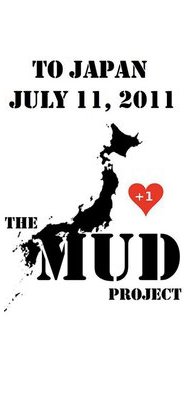
7. “Save Miyagi was founded by Canon Purdy (Miyagi-ken, 2008-10) to help out students in Minamisanriku. Canon is currently back in Japan, working with officials to see where the money will be used.” (Thanks to Jen Wang (Miyagi-ken) for passing on the info.)
8. Hotdogs and Hugs is an aid organization formed by Saga-ken JETs. Among other things, they organized a volunteer group that traveled all the way from Saga (western Kyushu) up to Tohoku, collecting donations and fundraising along the way. (Thanks to Ling Tran (Saga-ken, Yoshinogari-shi, 2009-11) for passing on the info.)
9. Osaka AJET: “We have done extensive food drives and collections through our schools we work in, those goods, money, supplies have then been coordinated with Kozmoz International (A small not-for profit in Kyoto) and we have taken the needed items to Tohoku ourselves. We will be doing another drive across Osaka, hopefully in dozens of schools where JETs are placed from the start of this second term.” (Thanks to Matthew Cook, who serves as both AJET Chair and is a member of Osaka AJET, for sharing this info.)
10. The MUD Project: It turns out that Colin Renie (CIR Yamagata-ken, 2007-10) has been running a volunteer project that has enabled many JETs to volunteer in Tohoku with particular emphasis on Minamisanriku as well as other areas of Miyagi and Iwate. Lots of good info, photos and updates on the project’s Facebook page: https://www.facebook.com/mudproject
**********
What else is missing from this list?
Please post to the comments section or e-mail jetwit [at] jetwit.com with more info.
Yoroshiku!
Volunteering in Tohoku – message from a JET alum
This helpful info was recently posted to the Nagasaki JET yahoogroup by a JET alum for the benefit of current JETs, though it contains a great deal of potentially helpful info and perspective for the JET alum community as well. Have a comment or perspective on volunteering in Tohoku to share? Post to the comments section:
Hi. My name is Andrew Morris and I was an ALT in Sonogi, Nagasaki prefecture from 07-09. After that I moved up to Kyoto for two years and then I just moved back to the U.S..
However, the reason for this email is that just before I made the fabled journey “home” this month, I was able to free up enough time in my schedule to allow myself to take two separate volunteer trips up to the Ishinomaki City area in Miyagi Prefecture, which was amongst the hardest hit areas by the tsunami/quake in March. The part where I did most of my work was on the Oshika Peninsula, which was actually the very area that was featured in the great short movie (http://vimeo. com/24037794) made by Mark Flanigan another former JET.
My experiences up there were both just as I thought and completely different. I shoveled an insane amount of mud, I hauled debris of all varieties for days, I crawled through mounds of fly infested ropes trying to salvage buoys, and I sang drunken karaoke with the local fisherman when it was all done. It was an experience I will carry with me forever and in that short time I met some of the most amazing people I ever have and made connections that will last a lifetime. I can assure you that my experience was not unique.
The reason I have for wanting to tell you about my experiences, though, is that I want to encourage each and every one of you to seriously consider going up there to try to do the same. As I’m sure you’re well aware, summer vacation is nearly here, and you may still be considering how to spend yours. I know sitting in the office figuring out new and interesting ways to stay busy sounds like fun now but… Who knows, if you’re industrious enough, you may even be able to put together a project out of taking a trip up there help out and convince your school you should be able to do it without taking nenkyu. Worth a shot at least right? Even if you have to take vacation, it would be much more meaningful in a lifelong sense then lounging on a beach somewhere (though no offense if you’ve already got your tickets to do that). Trust me, if you do it your stature in the shokuinshitsu will increase 100 fold.
To see pictures from my trip please visit – anmorris.photoblog.com
Further to my encouragement, I’d like to offer some information about going up there and hopefully dispel a few myths that I myself was quite worried about before heading up there.
- Transportation myth – It’s hard to get there. Reality = It’s not. I mean, it’s far but trains and buses to Sendai are in full working order. In fact I found it quite cheap. Turns out there’s a ¥6,000 night bus from Kyoto to Sendai. Or if you have access to a car you could even make it into an epic road trip. It would also definitely benefit you to have personal transport while up there, although not essential. From Sendai City there’s a ¥800 highway bus (bus stop 33) that takes you directly to Senshu University, which is the volunteer basecamp for Ishinomaki. Downtown Sendai itself barely looks like it even suffered any damage really.
- Lack of volunteer groups myth – It’s not easy to join a volunteer group. Reality = Depends on the group. Some of the bigger groups like peace boat, while great, require volunteers to attend an orientation in Tokyo before going which can be a huge hassle if you’re not from there. However, there are a bunch of other smaller groups doing great work in the area that need all the help they can get. Contact Robert Mangold and he can put you in touch with a bunch (idrojapan [at] gmail. com)
- Food myth – It’s hard to get so you have to bring it all up with you. Reality = It’s not hard at all to get it and the people there have more than they need. In fact volunteers are fed off of left over food from the shelters, and sometimes there is even more than they can eat. Plus there are supermarkets and convenience stores open in the town you can use. Even down on the peninsula the konbini‘s are starting to open up. Water is pretty much the same issue, and drinks of all varieties are now readily available, which is going to be especially important in the coming summer months.
- Work myth – It’s all really hard manual labor. Reality = That is available in spades, but so are any number of other jobs. Some people help cook food for the shelters. People go and spend time with the kids or do performances at the shelters. Some people give massages or acupuncture to people who suffer from physical issues or stress (obviously licensing or some professional experience is highly valued in such a case). Some people work cleaning photos found in the rubble for display so that the owners might find them again. If you have any sort of applicable skill or an idea for a project that might be useful in this sort of situation I’m sure they’d love to hear about it. Heck, you could probably just go and offer free “English Conversation” and they’d love it!
- Gear myth – You have to go out and buy tons of gear before you go like boots, a helmet, gloves, masks, etc. which can cost a lot of ¥¥¥. Reality = Unless you sign up with a volunteer group that requires you to have these things, or unless you go up with a whole herd of volunteers then it’s probably not necessary. The group I volunteered with had plenty of that equipment for me and all the other volunteers. Especially if you aren’t going to be doing the nitty gritty work, you won’t need any of that type of equipment. However, one thing I would suggest bringing if you do plan to do debris cleanup is steel insoles for boots. There’re lots of nails and other sharp things all around as you can imagine so they can really save you a very painful experience. Also, if you have “outsized” feet or hands, etc. it may be good to bring your own gear.
- Sadness myth – The overwhelming sadness of the situation will leave you depressed. Reality = Well, obviously this is entirely an individual issue, and everyone reacts differently to these situations. However I will just say that although the destruction you encounter there is just entirely unbelievable, and the people you meet there have often been through absolutely devastating experiences, in general, I found both the locals and the volunteers to be in incredibly high spirits. The positive energy they displayed in taking on this massive project of putting their lives and communities in order was nothing short of inspirational. I dare say that a good portion of the time I was having… fun (see drunken karaoke above).
Some words of caution:
-All that said, it is a difficult, trying experience and should not be undertaken on a whim.
-As was pointed out in a previous email from CLAIR, it is extremely important to think about “Volunteering Responsibility.” It is not a vacation, and you should do your very best to make sure that you do not need to be taken care of.
-Some of the jobs are quite dangerous (although every precaution is taken) and you should consider which role you can play safely.
Some words of advice:
-Speaking Japanese is not entirely essential, but it is extremely beneficial. This goes in the “making sure you’re not a burden” section. Try to go up there with someone who can communicate well so you can receive instructions and know what’s going on if possible.
-As you’re well aware it’s going to be bloody hot. They told me it’s cooler along the coast than many places thanks to the cool breeze, but still, it’s Japan in July/August… Be prepared. That means lots of fluids, and buckets of sunscreen.
Feel free to contact me with any questions too (anmorris [at] gmail. com). Good luck with whatever you do and enjoy your remaining time in that wonderful wonderful country!
Ganbaro Nippon!
Thanks to Matt Gillam of CLAIR NY for forwarding this on.
Apparently two Shiga JETs covered the two kilometers between Moriyama and Otsu in a little over an hour to raise approximately300,000 yen. Based on the katakana, I believe their names are Dusty Wittman and Roxy Borowska. (Thanks to Katie Jardine for the name correction!)
2011年7月16日21時46分
ペットボトル船で琵琶湖横断 震災孤児への募金呼びかけ
東日本大震災で親を失った震災孤児への募金を呼びかけようと、滋賀県内の高校に勤務する外国語指導助手(ALT)の2人が16日、ペットボトル815本を使った長さ約2メートルのボートで琵琶湖を横断した。
挑戦したのは米国出身のダスティ・ウイットマンさん(30)と英国出身のロキシィ・ボロウスカさん(26)。守山市から対岸の大津市まで約2キロを 1時間 余りで横断した。米国では募金を求める「本気度」をパフォーマンスで示すことが多いといい、ALTの仲間や高校生らとペットボトルを集めて準備。2人は 「大好きな日本の子どものため、思いを行動で示したかった」と話す。
2人は3日から募金サイト(http://ilovenihon.com/)などで義援金を募り、国内外から約30万円が寄せられているという。ボロウスカさんは「地元の人も一緒に盛り上げてくれてうれしかった。今後も支援を訴えていきたい」と話す。
Surviving in Japan: How to stay cool without air conditioning
Posted by Ashley Thompson (Shizuoka-ken, 2008-2010) of Surviving in Japan: without much Japanese and Lifelines columnist for The Japan Times.

冷風扇 or "cool air fan"
The last week or so has been rather hot (in central Japan at least), with temps here in Shizuoka hovering around 30 Celsius and up (high 80s to 90s Fahrenheit). My husband and I still don’t own an air conditioner, simply due to the costs involved with buying and installing one, and then periodic cleaning. Yet, being 33 weeks pregnant, I’ve been finding myself desperate for some kind of cooling alternative the past week or so.
I never really felt like I needed an aircon since arriving in Japan three years ago. I was happy to experience nice, hot summers. People tend to complain a lot about the summer heat in Japan (unless they live in Hokkaido), but I hate the cold so much that I’m usually relieved when summer comes around.
Until last summer anyway, when we had a record-breaking heat wave that lasted until October. Sitting and working at home was mostly tortuous, so I trekked to the nearest Starbucks a few times a week just so I could get some work done in an air-conditioned, non-smoking, wi-fi equipped environment.
And now we’re into summer 2011. Temperatures are already mirroring those of last year on some days. I’m making due the best I can, but all this extra blood running through my body and 10 extra kilograms seems to make me feel hotter than I felt even last year.
After feeling sick the other day from trying to work inside (and I do still try to get out in the afternoon and at least run errands to air-conditioned places), I was about ready to build my own air conditioner.
I found this article on how to construct a makeshift one with a fan, styrofoam box cooler, and ice, and was seriously planning to go find the materials. Regular electric fans weren’t working, even with multiple ones blowing from all directions to circulate air. Drinking ice water helped only a little, and I was hopping in the shower every so often for a quick spray of cold water.
And then my husband mentioned he’d heard about some kind of machine that blows cool air (no, not an aircon), known as 冷風扇 (れいふうせん, reifuusen), or 冷風機 (れいふうき, reifuuki), or “cool air fan/machine” as a loose translation.
Essentially, you put cold water and ice–CLICK HERE to read the rest of the post.
Visit all 47 prefectures in Japan in 100 days — for free! (But there’s a catch…)
I’ve seen this posted several places and also had it sent to me by JET alum and President of Music City JETAA Terry Vo (2007-09, Kumamoto-ken) . So while no JET alums would be eligible, maybe our extensive alumni community might know someone who is.
The Offer: Some lucky person will win 100 days to visit all 47 prefectures in Japan and blog about it.
The Catch: You can’t have ever lived in Japan before.
More Info Here: http://travelvolunteer.net/
By the way, for tourism info on all 47 prefectures, here are the tourism sites for each prefecture (which I organized in a JETwit post back in early June):
- Local Japan: Prefecture Tourism Links: http://jetwit.com/wordpress/2011/06/02/local-japan-prefecture-tourism-links/


